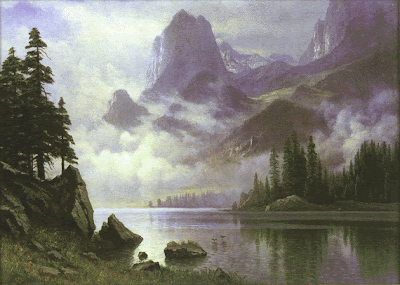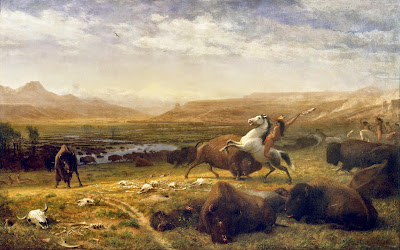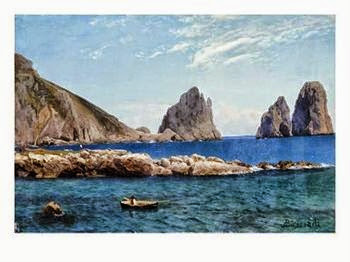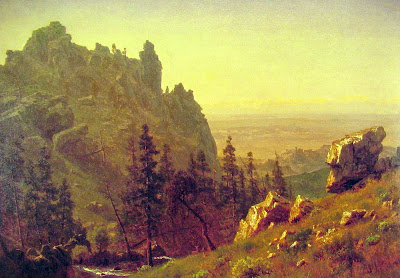
Albert Bierstadt (Sinh ngày 7/1/ 1830 - mất ngày 18/2/ 1902) là một nhà họa sỹ có hai dòng máu Đức-Mỹ, ông nổi tiếng với các bức ảnh phong cảnh sang trọng và sâu rộng của vùng Tây Mỹ. Để thể hiện các bức họa, Bierstadt đã tham gia nhiều chuyến đi khám phá vùng phía tây mở rộng. Mặc dù không phải họa sỹ đầu tiên khám phá những địa điểm trên, Bierstadt là họa sỹ bậc nhất về vùng đó cho đến hết thứ kỷ 19. Sinh ra ở Đức, Bierstadt được bố mẹ đưa đến Mỹ khi 1 tuổi. Sau đó ông quay lại học vẽ nhiều năm ở Düsseldorf. Ông ta trở thành 1 phần của trường phái sông Hudson ở New York, một nhóm tự lập về những họa sỹ có tư duy giống nhau, những người cùng vẽ về vẻ đẹp của dòng sông. Phong cách của họ dựa trên những chi tiết lãng mạn, hầu như theo kiểu tăng sáng, nhiều khi còn gọi là trường phái chói sang. Người truyền tải quan trọng của cảnh đẹp vùng Tây Mỹ - Bierstadt, cùng với Thomas Moran, được xếp vào trường phái Rocky Mountain.
Albert Bierstadt (January 7, 1830 – February 18, 1902) was a German-American painter best known for his lavish, sweeping landscapes of the American West. To paint the scenes, Bierstadt joined several journeys of the Westward Expansion. Though not the first artist to record these sites, Bierstadt was the foremost painter of these scenes for the remainder of the 19th century.
Born in Germany, Bierstadt was brought to the United States at the age of one by his parents. He later returned to study painting for several years in Düsseldorf. He became part of the Hudson River School in New York, an informal group of like-minded painters who started painting along this scenic river. Their style was based on carefully detailed paintings with romantic, almost glowing lighting, sometimes called luminism. An important interpreter of the western landscape, Bierstadt, along with Thomas Moran, is also grouped with the Rocky Mountain School.
Bierstadt was born in Solingen, Germany. The following year, his family moved to New Bedford, Massachusetts, in 1831. He developed a taste for art early and made clever crayon sketches in his youth. In 1851, he began to paint in oils.
He returned to Germany in 1853 and studied painting for several years in Düsseldorf with members of its informal school of painting. After returning to New Bedford in 1857, he taught drawing and painting briefly, before devoting himself full-time to painting.
In 1858 he exhibited a large painting of a Swiss landscape at the National Academy of Design, which gained him positive critical reception and honorary membership in the Academy. At this time Bierstadt began painting scenes in New England and upstate New York, including in the Hudson River valley. A group of artists known as the Hudson River School portrayed its majestic landscapes and craggy areas, as well as the light affected by the changing waters.
In 1859, Bierstadt traveled westward in the company of Frederick W. Lander, a land surveyor for the U.S. government, to see those landscapes. He returned to a studio he had taken at the Tenth Street Studio Building in New York with sketches that would result in numerous finished paintings. In 1863 he traveled west again, this time in the company of the author Fitz Hugh Ludlow, whose wife he would later marry. Throughout the 1860s, Bierstadt used studies from this trip as the source for large-scale paintings for exhibition. He continued to visit the American West throughout his career.
During the American Civil War, Bierstadt paid for a substitute to serve in his place when he was drafted in 1863. He completed one Civil War painting Guerrilla Warfare, Civil War in 1862, based on his brief experiences with soldiers stationed at Camp Cameron in 1861. Bierstadt's painting was based on a stereo photograph taken by his brother Edward Bierstadt, who operated a photography studio at Langley's Tavern in Virginia. Bierstadt's painting received a positive review when it was exhibited at the Brooklyn Art Association at the Brooklyn Academy of Music in December 1861. Curator Eleanor Jones Harvey observes that Bierstadt's painting, created from photographs, "is quintessentially that of a voyeur, privy to the stories and unblemished by the violence and brutality of first-hand combat experience.
In 1860 he was elected a member of the National Academy; he received medals in Austria, Bavaria, Belgium, and Germany. In 1867 he traveled to London, where he exhibited two landscape paintings in a private reception with Queen Victoria. He traveled through Europe for two years, cultivating social and business contacts to sustain the market for his work overseas.
A trip to the Yellowstone region in 1871 yielded numerous drawings of the area's geysers and picturesque topography. These works were instrumental in convincing the United States Congress to pass the Yellowstone Park Bill in 1872, thus establishing the first national park in the world. Soon thereafter Congress purchased a large painting from Bierstadt for $10,000. As a result of the publicity generated by his Yellowstone paintings, Bierstadt's presence was requested by every explorer considering a westward expedition, and he was commissioned by the Atchison, Topeka, and Santa Fe Railroad to visit the Grand Canyon for further subject matter.
Bierstadt's technical proficiency, earned through his study of European landscape, was crucial to his success as a painter of the American West. It accounted for his popularity in disseminating views of the Rockies to those who had not seen them. The immense canvases he produced after his trips with Lander and Ludlow established him as the preeminent painter of the western American landscape. Financial recognition confirmed his status: The Rocky Mountains, Lander's Peak, completed in 1863, was purchased for $25,000 in 1865.
Despite his popular success, Bierstadt was criticized by some contemporaries for the romanticism evident in his choices of subject and his use of light was felt to be excessive. His exhibition pieces were brilliantly crafted images that glorified the American West as a land of promise. Bierstadt's choice of grandiloquent subjects was matched by his enterpreneurial flair. His exhibitions of individual works were accompanied by promotion, ticket sales, and, in the words of one critic, a "vast machinery of advertisement and puffery."
His wife was diagnosed with consumption in 1876, and from then until her death in 1893, Bierstadt spent time with her in the warmer climate of Nassau in the Bahamas. He also continued to travel to the west and Canada. In later life, Bierstadt's work fell increasingly out of critical favor. It was attacked for its theatrical tone.
In 1882 Bierstadt's studio at Irvington, New York, was destroyed by fire, resulting in the loss of many of his paintings. By the time of his death in 1902, the taste for epic landscape painting had long since subsided. Bierstadt was then largely forgotten. He was buried at the Rural Cemetery in New Bedford, Massachusetts.
Interest in his work was renewed in the 1960s, with the exhibition of his small oil studies. The subsequent reassessment of Bierstadt's work has placed it in a favorable context:
Bierstadt was a prolific artist, having completed over 500 paintings during his lifetime. Many of these are held by museums across the United States.
















































































.jpg)


















































































































































































































No comments:
Post a Comment